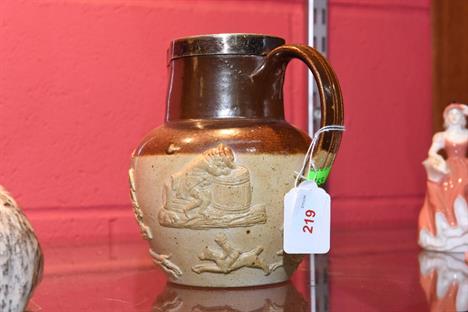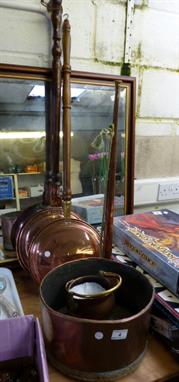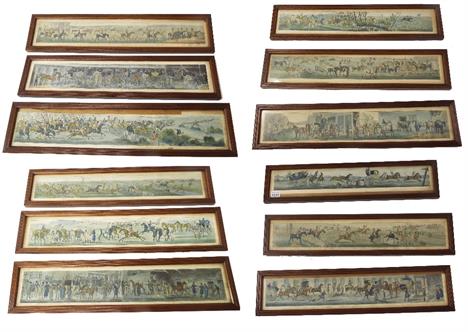We found 74924 price guide item(s) matching your search
There are 74924 lots that match your search criteria. Subscribe now to get instant access to the full price guide service.
Click here to subscribe- List
- Grid
-
74924 item(s)/page
William Monk RE 1863-1937, three architectural etchings entitled `Westminster Abbey` and `St Johns Clerkenwell` and `Horseguards, Whitehall`, signed in pencil bottom right, framed and glazed together with a further work by Joseph Simpson 1879-1939 depicting a hunting man, framed and glazed. (4)
After Anson A Martin, The Bedale Hunt, engraved by W.H. Simmons with title To Mark Milbank Esq., Thorpe Perrow, Yorkshire... , framed and glazed together with coloured engraving titled `The Burial of Tom Moody` a hand coloured hunting photographic print of a huntsman with hounds and a framed photographic print of an 18th century landscape (4)
A Watkins and Doncaster 20 drawer mahogany collectors cabinet circa 1900 the hinged door with ivorine makers plaque Watkins & Doncaster, Cabinet manufacturers and Naturalists 36, Strand, London WC 125cm.; 45ins high by 52cm.; 20½ins wide by 47cm.; 18½ins deep drawer size 47cm.; 17ins wide by 38cm.; 15ins deep by 5cm.; 2ins high This twenty drawer cabinet is by a leading name in natural history paraphernalia and equipment. Watkins and Doncaster were founded in the 19th century in London and are still active, although somewhat less central now being base near Hereford. The cabinet contains a superb collection of British moths by Sid Imber and, again, The quality of work and standard of setting is of the very highest level. All have data and are in excellent condition. Sidney Imber was born in 1925 in Brixton fire station where his father was a serving full time fireman at that station. (‘This was a time when firemen and their families actually lived on site’). Aged 17 and a half years ‘Sid’ joined the Royal Marines and trained at Chatham. His war was spent in Burma where he fought for two years under Mountbatten and was awareded the Burma Star. He returned to the U.K. in 1946 where he met his wife to be. He married Olive who was one of ‘Rothschilds Girls’ and he joined the Metropolitian Fire Service where he served for 33 years rising to the position of Commander of the London Fire Service. Oliver Imber who worked as P.A. for the Rothschild family has been married to Sid for 63 years and recalls that according to Sid’s mother he was always interested in insects. Even as a baby in the pram his attention would be trained on a butterfly or beetle as if transfixed. For Olive and the perfect holiday (and their courtship) was spent riding though the countryside together hunting for butterflies and insects. They travelled all over the British Isles on this pursuit and , indeed, all over the world building Sid’s superb collection of butterflies, moths and other insects. Sid’s attention to detail and the correct labelling of his specimens is commendable. His ability to ‘set’ and insect is second to none. He achieves perfection again and again. He believed that every specimen in a collection should be taken by the collector himself and specimens from other sources should not be included. To this end it was not unusual when in the field for his wife Olive to make an interesting capture and offer it to Sid only to be told to release the specimen so that Sid could genuinely ‘net’ the insect himself in order to add it to his collection! The following three lots which contain nearly 2000 specimens bear witness to Sid Imber’s absolute focus on perfect setting, totally comprehensive labelling and taxonomic order. Data labels are of extreme importance with any natural history collection and all the specimens herewith have full date and provenance. The quality of the setting and layout is superb and the three cabinets encompass the three most famous makers, Gurney, Brady and Messrs Watkins and Doncaster.
Charles Towne (British, 1763-1840) A Marlborough spaniel in a wooded landscape, a windmill beyond signed lower right ""C Towne 1830"" on the right-hand rock oil on panel 34 x 43cm (13 x 17in) During the early part of the 18th century, John Churchill, 1st Duke of Marlborough, kept red and white King Charles type spaniels for hunting. The duke recorded that they were able to keep up with a trotting horse. His estate was named Blenheim in honour of his victory at the Battle of Blenheim. Due to this influence, the red and white variety of the King Charles Spaniel and thus the Cavalier King Charles Spaniel became known as the Blenheim. XG 683 - Christie`s stencil mark to the reverse. Cleaned at some stage. Paint layer in good condition. A few areas of abrasion, notably along the upper edge. Varnish layer thick and glossy. Some losses to gilding on the frame.
* A LARGE LISINSKY BEAR RUSSIAN, AFTER A MODEL BY NIKOLAI LIEBERICH, INSCRIBED WITH A SIGNATURE, C.F. WOERFFEL FOUNDRY, ST PETERSBURG Bronze with dark brown patina, height 56 cm. Small bronze sculptures destined for interiors became fashionablein Russia in the second half of the 19th century. Hunting scenes, already a popular subject in paintings and drawings, not least becauseof Emperor Alexander II?s passion for hunting, were now embracedin sculpture. Alexander II was an avid hunter and from an early age, hunting was an essential part of his leisure activities. At the tender age of 10, Alexander Nikolaevich was already accomplished with a rifle. Upon enthronement, the Tsesarevich?s hobby became the Emperor?s fully-fledged hunting seasons, which began during the Coronation festivities in 1856. The hunting lodge in Lisino, built by Nikolai Benois, was a favourite of Emperor Alexander II and where he stayed on some 86 occasions. Such lodges were decorated with various hunting trophies, depictions of the Imperial hunt and the animal statues, for which Nikolai Lieberich is the most famous. In 1865?1866, Lieberich was invited to partake in the Imperial hunt, which provided a valuable source of observation and inspiration for his work. A bear killed by the Emperor during a hunt in Lisino, became the prototype for this highly popular model, executed in 1866. Whilst Lieberich?s works were highly praised at court in the 19th century, they are still sought after today. For example, a specially commissioned bronze-gilt casket with a hunting scene by the sculptor was sold by Sotheby?s in 2011 for almost £140,000. The present cast, with its sharp and precise elaboration of detail, is an example of Lieberich?s animal sculpture at its best.
* A LARGE LISINSKY BEAR RUSSIAN, AFTER A MODEL BY NIKOLAI LIEBERICH, INSCRIBED WITH A SIGNATURE, C.F. WOERFFEL FOUNDRY, ST PETERSBURG Bronze with dark brown patina, height 56 cm. Small bronze sculptures destined for interiors became fashionablein Russia in the second half of the 19th century. Hunting scenes, already a popular subject in paintings and drawings, not least becauseof Emperor Alexander IIs passion for hunting, were now embracedin sculpture. Alexander II was an avid hunter and from an early age, hunting was an essential part of his leisure activities. At the tender age of 10, Alexander Nikolaevich was already accomplished with a rifle. Upon enthronement, the Tsesarevichs hobby became the Emperors fully-fledged hunting seasons, which began during the Coronation festivities in 1856. The hunting lodge in Lisino, built by Nikolai Benois, was a favourite of Emperor Alexander II and where he stayed on some 86 occasions. Such lodges were decorated with various hunting trophies, depictions of the Imperial hunt and the animal statues, for which Nikolai Lieberich is the most famous. In 18651866, Lieberich was invited to partake in the Imperial hunt, which provided a valuable source of observation and inspiration for his work. A bear killed by the Emperor during a hunt in Lisino, became the prototype for this highly popular model, executed in 1866. Whilst Lieberichs works were highly praised at court in the 19th century, they are still sought after today. For example, a specially commissioned bronze-gilt casket with a hunting scene by the sculptor was sold by Sothebys in 2011 for almost £140,000. The present cast, with its sharp and precise elaboration of detail, is an example of Lieberichs animal sculpture at its best.
After Montague Dawson (20th/21st century) "Racing Wings" a coloured reproduction, 53 x 74 cm, together with various other decorative pictures after Sir Alfred Munnings, , "The Paddock", also a stone lithograph depicting Malvern from the Worcestershire Beacon, looking North, and companion "Looking South" (in one frame) a watercolour initialled E.D.A and dated 1937, later hunting prints and other reproductions, (various sizes) a collection,
AN 18CT GOLD HUNTING CASED FREE SPRUNG CHRONOMETER WATCH by Victor Kullberg London, No 4594, casemaker John Martin, London 1884, 52mm diam++Not working: detent broken or missing. Balance not broken; no rust and clean and in externally good condition In the present family ownership for many decades and fresh to the market. A watch of superb quality but requiring a highly skilled repair
A 19TH CENTURY SILVER MOUNTED STONEWARE HUNTING JUG having a silver mount with hinged cover, foliate thumb piece, plain neck, loop handle and half buff body decorated in relief with typical scenes and figures, the mounts with marks for London 1822, maker J Wrangham & William Moulson. 25cm(h)CONDITION: Generally good, mounts possibly associated.
AN EARLY 19TH CENTURY SILVER MOUNTED STONEWARE HUNTING JUG having a silver mount with hinged cover and foliate thumb piece, a plain neck, loop handle and half buff body decorated in relief with typical scenes and figures, the mounts with marks for London 1822, maker J Wrangham & William Moulson. 20cm(h)CONDITION: Generally good, mounts possibly associated.
AN 18CT GOLD HUNTING CASED FREE SPRUNG CHRONOMETER WATCH by Victor Kullberg London, No 4594, casemaker John Martin, London 1884, 52mm diam++Not working: detent broken or missing. Balance not broken; no rust and clean and in externally good condition In the present family ownership for many decades and fresh to the market. A watch of superb quality but requiring a highly skilled repair
HUNTING / GAMEKEEPING: BRYDEN (H.) Enchantments of the Field, 8vo, plates, clo., d.w., L., 1930; De CRESPIGNY (Sir C. C.) Forty Years of a Sportsman’s Life, 8vo, plates, clo., 1st Edn., L., 1910; & 2 others; JONES (O.) Ten Years of Game-keeping, 8vo, photo plates, clo., 1st Edn., L., 1909; HILLS (J.) River Keeper, 8vo, frontis, clo., d.w., 1st Edn., L., 1934. (6)
BAILY’S MAGAZINE of Sports and Pastimes, vols. 82 & 85-90 [1904, 1906-1908], 8vo, uniformly bound in red/black cloth gilt (some damp to covers); & odd vols. for 1865, 1893, 1903; TAUTZ (E.) publisher: The Hunting Diary and Guide for 1913-14, 8vo, illus., clo., L., [1912]; FORES’s Sporting Notes & Sketches, 2 vols., (a/f.) 1895 & 1902 (13, w.a.f.).
DAVIES (E.) Memoir of the Rev. John Russell, sm. 4to, col’d plates by N. Baird, clo., L., 1902; LUTYENS (F. M.) Mr Spink and his Hounds, 8vo, illus., clo., L., [ca. 1900]; Lays of the Belvoir Hunt, 8vo, clo., 1st Edn., Grantham, 1866; HAWKES (J.) The Meynellian Science or Fox-Hunting System, 8vo, illus., LTD EDN. reprint, 24/500, clo., Leicester 1932; BURROWS (G.) Gentleman Charles, A History of Foxhunting, 1951 (4).
-
74924 item(s)/page







![[Fox hunting interest] A William IV silver oblong snuff box by Sampson Mordan & Co., London 1834, stamped S. MORDAN &](http://lot-images.atgmedia.com/SR/35870/2915467/74-2014111014129_468x382.jpg)































